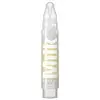What's inside
What's inside
 Key Ingredients
Key Ingredients

 Benefits
Benefits

 Concerns
Concerns

 Ingredients Side-by-side
Ingredients Side-by-side

Vitis Vinifera Seed Oil
EmollientPersea Gratissima Oil
Skin ConditioningSqualane
EmollientTetrahexyldecyl Ascorbate
AntioxidantHippophae Rhamnoides Oil
EmollientPrunus Armeniaca Kernel Oil
MaskingCitrus Grandis Peel Oil
MaskingCitrus Limon Peel Oil
MaskingCitrus Nobilis Peel Oil
MaskingCitrus Reticulata Peel Oil
MaskingCurcuma Longa Root Oil
PerfumingTocopheryl Acetate
AntioxidantLecithin
EmollientParfum
MaskingLimonene
PerfumingCitral
PerfumingGeraniol
PerfumingLinalool
PerfumingCitronellol
PerfumingVitis Vinifera Seed Oil, Persea Gratissima Oil, Squalane, Tetrahexyldecyl Ascorbate, Hippophae Rhamnoides Oil, Prunus Armeniaca Kernel Oil, Citrus Grandis Peel Oil, Citrus Limon Peel Oil, Citrus Nobilis Peel Oil, Citrus Reticulata Peel Oil, Curcuma Longa Root Oil, Tocopheryl Acetate, Lecithin, Parfum, Limonene, Citral, Geraniol, Linalool, Citronellol
Aloe Barbadensis Leaf Juice
Skin ConditioningTetradecane
PerfumingHydrogenated Polydecene
EmollientGlycerin
HumectantDisteardimonium Hectorite
StabilisingPolyglyceryl-3 Diisostearate
EmulsifyingDecyl Isostearate
EmollientIsostearyl Isostearate
EmollientIsostearic Acid
CleansingMethyl Methacrylate Crosspolymer
Propanediol
SolventSorbitan Sesquiisostearate
EmulsifyingPolyglyceryl-6 Polyricinoleate
EmulsifyingGluconolactone
Skin ConditioningLauroyl Lysine
Skin ConditioningAlbizia Julibrissin Bark Extract
MaskingMagnesium Sulfate
Sodium Chloride
MaskingZinc Stearate
Cosmetic ColorantHydrogenated Lecithin
EmulsifyingTetrahexyldecyl Ascorbate
AntioxidantSodium Benzoate
MaskingDodecane
PerfumingCaprylic/Capric Triglyceride
MaskingHexadecane
PerfumingPistacia Lentiscus Gum
MaskingCalcium Gluconate
HumectantEthylhexylglycerin
Skin ConditioningDarutoside
Skin ConditioningPhenethyl Alcohol
MaskingCI 77891
Cosmetic ColorantCI 77491
Cosmetic ColorantCI 77492
Cosmetic ColorantCI 77499
Cosmetic ColorantAloe Barbadensis Leaf Juice, Tetradecane, Hydrogenated Polydecene, Glycerin, Disteardimonium Hectorite, Polyglyceryl-3 Diisostearate, Decyl Isostearate, Isostearyl Isostearate, Isostearic Acid, Methyl Methacrylate Crosspolymer, Propanediol, Sorbitan Sesquiisostearate, Polyglyceryl-6 Polyricinoleate, Gluconolactone, Lauroyl Lysine, Albizia Julibrissin Bark Extract, Magnesium Sulfate, Sodium Chloride, Zinc Stearate, Hydrogenated Lecithin, Tetrahexyldecyl Ascorbate, Sodium Benzoate, Dodecane, Caprylic/Capric Triglyceride, Hexadecane, Pistacia Lentiscus Gum, Calcium Gluconate, Ethylhexylglycerin, Darutoside, Phenethyl Alcohol, CI 77891, CI 77491, CI 77492, CI 77499
Ingredients Explained
These ingredients are found in both products.
Ingredients higher up in an ingredient list are typically present in a larger amount.
Tetrahexyldecyl Ascorbate (THD) is a stable and oil-soluble form of Vitamin C.
THD is special in that it has the ability to travel deeper into skin than traditional ascorbic acid while maintaining the same skin benefits (double win!).
Because it’s oil-soluble, THD dives deep into your skin’s fatty layers (think ceramides and cholesterol) to fight off the kind of free radicals that mess with your skin barrier. This makes it a great pair with water-based vitamin C (ascorbic acid) that mainly works on the surface.
Even at just 0.1%, THD is already showing great antioxidant activity. When used up to 2%, it helps keep your skin happy and calm, especially when it’s stressed from pollution or sun.
Want to fade dark spots or tackle hyperpigmentation? You’ll want 5% or more. Pairing it with brightening buddies like niacinamide or licorice root gives even better results. One study even used 30% THD with other brighteners and saw real results on stubborn discoloration, even in melasma-prone skin.
A note on THD: It’s has a slightly silky, oily texture and usually shows up colorless or pale yellow (though the exact shade can vary by supplier).
While you can sneak it into water-based formulas, it really shines when paired with silicones or oils, which help your skin soak it up better.
THD is pretty stable, but it’s still vulnerable to degradation like ascorbic acid. Too much light or heat (above 113°F / 45°C) can break it down over time. Go for dark and opaque packaging that keeps it safe and shady!
Read more about other types of Vitamin C:
Learn more about Tetrahexyldecyl Ascorbate